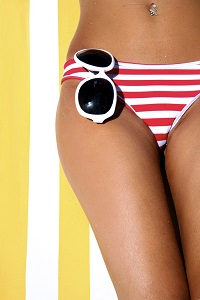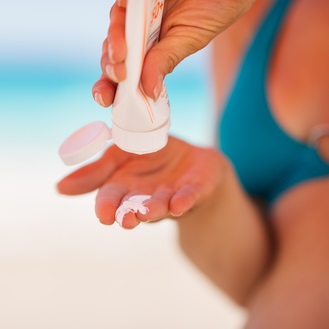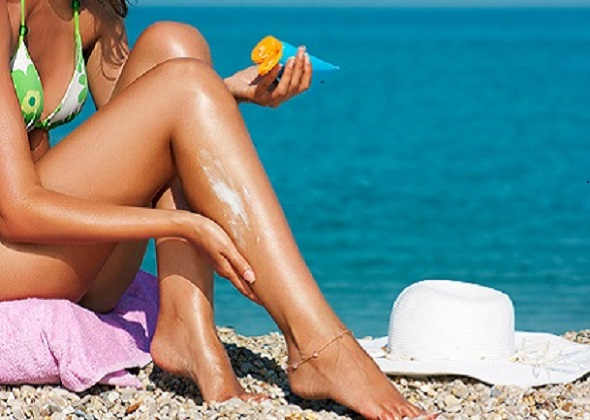Sunscreen. What a boring subject. But, I’m sure you know that UV Rays are the main reason that an anti-aging beauty blogger like myself has anything to write about. After all, sun damage is a key factor in premature aging, causing such nuisances as age spots, wrinkles, and loss of elasticity. And don’t forget about skin cancer!
There’s no way around it, sunscreen is in and the sun is out. It seems pretty painless after all. I mean, makeup manufacturers have been adding SPF to their makeup for years, so can’t we just slather on our SPF20 foundation in the morning and get on with the day? Oh ladies, if only life were so simple.
In order to understand the how’s and what’s of sun protection, it’s important to know that there are two kinds of UV (ultra violet) rays to be concerned about. UVB (Ultra Violet B), that attacks the outer layers of skin, causing sunburn and exposing you to these cancer causing rays. The good news about UVB is that it can’t penetrate through glass so, if you’re vegging out in your casa, you’re safe and protected.
Then there’s UVA (Ultra Violet A) that penetrates the deeper layers of your skin and causes aging. These rays can get to you through the windows in your house, car and office. UVA rays make it necessary to wear sunscreen no matter what you’re doing or where you’re at.
 While I’m in glossary mode, let’s talk about SPF (Sun Protection Factor). What exactly does that mean? Well, according to the American Cancer Society, it takes 20 minutes for your skin to burn. Hate to tell you, ladies, but that golden tan is considered a burn and 20 minutes is only the average. I know when I’m in the sun I start baking at 10 minutes so consider that. Anyhow, the strength of SPF is simply a multiplier of the time you can spend in the sun before the UVB (remember, the one that burns you) starts its handiwork.
While I’m in glossary mode, let’s talk about SPF (Sun Protection Factor). What exactly does that mean? Well, according to the American Cancer Society, it takes 20 minutes for your skin to burn. Hate to tell you, ladies, but that golden tan is considered a burn and 20 minutes is only the average. I know when I’m in the sun I start baking at 10 minutes so consider that. Anyhow, the strength of SPF is simply a multiplier of the time you can spend in the sun before the UVB (remember, the one that burns you) starts its handiwork.
Assuming that 20 minutes is all it takes for someone to burn, then SPF15 will give you 15x more protection, or allow you 5 hours before your skin starts to fry. For instance, with SPF 30, you will have 30x longer – or 10 hours more of sun protection. The American Cancer Society recommends using SPF of at least 30 to stay sun-safe. Sounds easy enough, but there are so many other factors to consider. I mean, if you’re going to go through the motions you may as well get it right.
Choosing your Sunscreen:
- Use a broad spectrum sunscreen of at least SPF30 in order to make sure you’re protected from both UVA and UVB rays.
- There is no such thing as waterproof or sweatproof sunscreen. The best you can do is water resistant, which comes in two versions, 40 mins and 80 mins. which indicates how long you are protected while swimming or sweating.
 Use a mineral-based sunscreen if you are going to be spending time outdoors – ones with zinc-oxide or titanium-oxide. Non-mineral based sunscreens, such as oxybenzone and octinoxate have chemicals that absorb UV rays, making it necessary to reapply about every two hours in order to stay effective. Mineral-based actually reflects the light from your skin keeping it protected for at least two times longer.
Use a mineral-based sunscreen if you are going to be spending time outdoors – ones with zinc-oxide or titanium-oxide. Non-mineral based sunscreens, such as oxybenzone and octinoxate have chemicals that absorb UV rays, making it necessary to reapply about every two hours in order to stay effective. Mineral-based actually reflects the light from your skin keeping it protected for at least two times longer.- Non-mineral based sunscreen must be applied 20 to 30 minutes before you go outside as it takes at least that long to soak in and dry, and until then it won’t be effective. Mineral based sunscreens begin to work immediately upon application.
- Sunscreen is necessary even when it’s overcast. On the cloudiest of days you can still expect to get 40% of the UV rays.
- Wear a hat when playing outdoors! Your scalp needs protection too! And keep in mind that clothing and hats only provide about SPF6 protection, so you may want to take a look at options providing UPF (ultraviolet protection factor) of 50 or more. J Crew, Athleta, Mott50, and Coolibar are good places to look for those items.
- Always apply at least a nickel sized portion of sunscreen on your face alone, or a shot glass full to cover you’re whole body (I have no problem with this, any reason to pull out a shot glass…)
- Clear Sprays are just as effective as lotions. Just make sure to give it time to dry between layers and apply 20 minutes before going into the sun. Other than that, all the same rules apply.
So, get your sunscreen situation in order before partying it up by the pool, or going to work, or even chilling in the house. We may have been naïve as youngins, but it’s never too late to start!

















